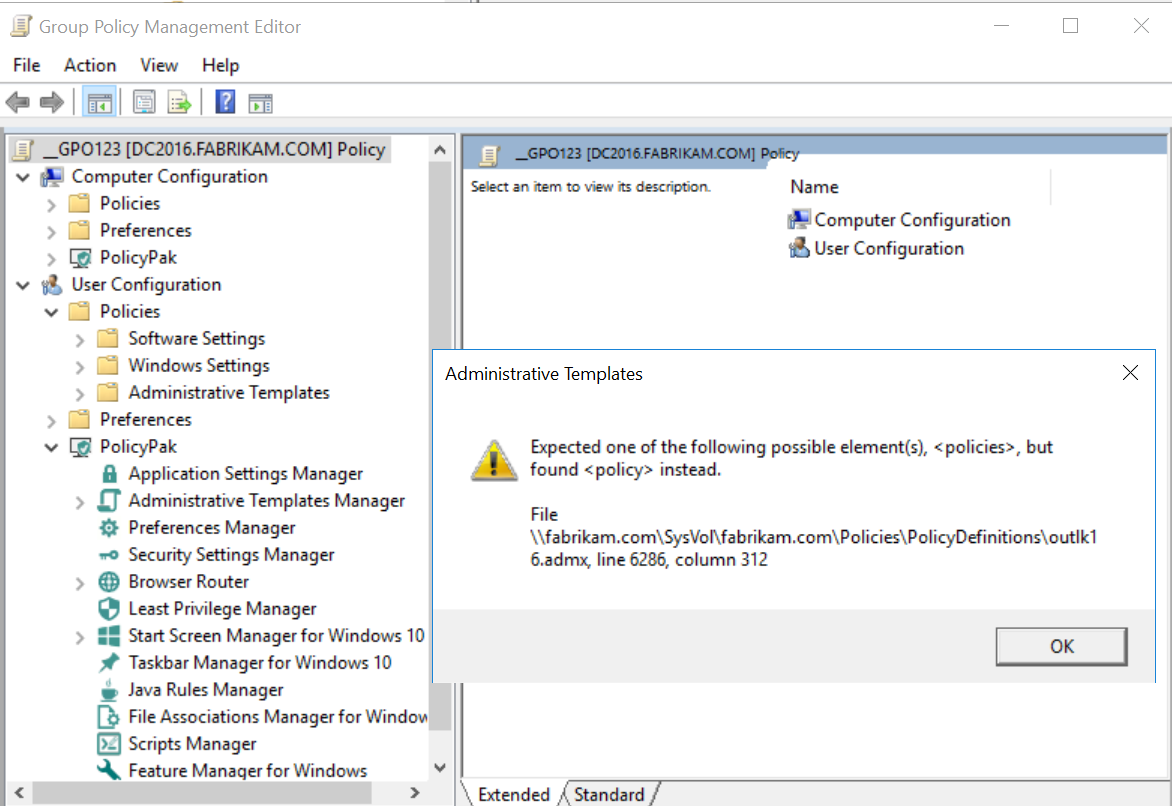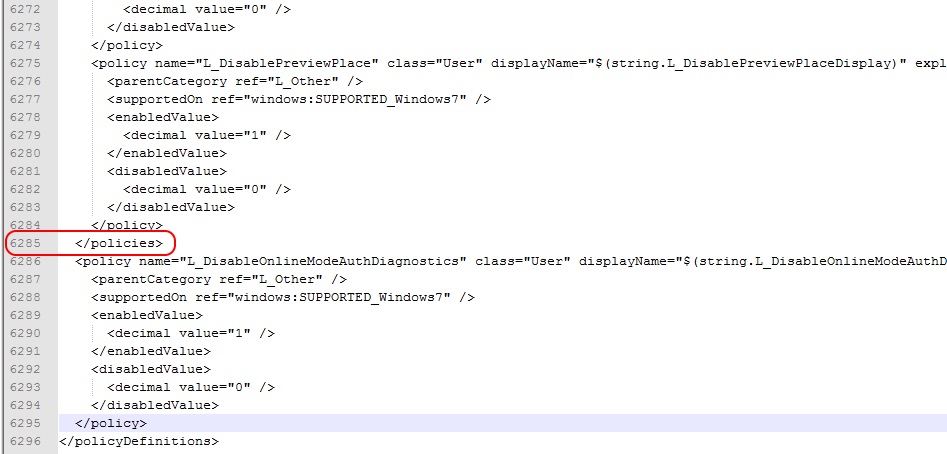| Scope |
Policy Path |
Policy Setting |
| Machine |
Control Panel |
Settings Page Visibility |
| Machine |
Network\Network Isolation |
Domains categorized as both work and personal |
| Machine |
Network\Network Isolation |
Enterprise resource domains hosted in the cloud |
| Machine |
System\App-V\PackageManagement |
Enable automatic cleanup of unused appv packages |
| Machine |
System\App-V\PowerManagement |
Enable background sync to server when on battery power |
| Machine |
System\Credentials Delegation |
Remote host allows delegation of non-exportable credentials |
| Machine |
System\Display |
Turn off GdiDPIScaling for applications |
| Machine |
System\Display |
Turn on GdiDPIScaling for applications |
| Machine |
System\Group Policy |
Configure web-to-app linking with app URI handlers |
| Machine |
System\Logon |
Configure Dynamic Lock |
| Machine |
System\Trusted Platform Module Services |
Configure the system to use legacy Dictionary Attack Prevention Parameters setting for TPM 2.0. |
| Machine |
Windows Components\App Privacy |
Let Windows apps access diagnostic information about other apps |
| Machine |
Windows Components\App Privacy |
Let Windows apps access Tasks |
| Machine |
Windows Components\App Privacy |
Let Windows apps run in the background |
| Machine |
Windows Components\BitLocker Drive Encryption |
Disable new DMA devices when this computer is locked |
| Machine |
Windows Components\BitLocker Drive Encryption\Operating System Drives |
Allow devices compliant with InstantGo or HSTI to opt out of pre-boot PIN. |
| Machine |
Windows Components\Data Collection and Preview Builds |
Configure Authenticated Proxy usage for the Connected User Experience and Telemetry service |
| Machine |
Windows Components\Delivery Optimization |
Allow uploads while the device is on battery while under set Battery level (percentage) |
| Machine |
Windows Components\Delivery Optimization |
Enable Peer Caching while the device connects via VPN |
| Machine |
Windows Components\Delivery Optimization |
Minimum disk size allowed to use Peer Caching (in GB) |
| Machine |
Windows Components\Delivery Optimization |
Minimum Peer Caching Content File Size (in MB) |
| Machine |
Windows Components\Delivery Optimization |
Minimum RAM capacity (inclusive) required to enable use of Peer Caching (in GB) |
| Machine |
Windows Components\Find My Device |
Turn On/Off Find My Device |
| Machine |
Windows Components\Internet Explorer\Internet Control Panel\Content Page |
Show Content Advisor on Internet Options |
| Machine |
Windows Components\Internet Explorer\Internet Control Panel\Security Page\Internet Zone |
Allow VBScript to run in Internet Explorer |
| Machine |
Windows Components\Internet Explorer\Internet Control Panel\Security Page\Intranet Zone |
Allow VBScript to run in Internet Explorer |
| Machine |
Windows Components\Internet Explorer\Internet Control Panel\Security Page\Local Machine Zone |
Allow VBScript to run in Internet Explorer |
| Machine |
Windows Components\Internet Explorer\Internet Control Panel\Security Page\Locked-Down Internet Zone |
Allow VBScript to run in Internet Explorer |
| Machine |
Windows Components\Internet Explorer\Internet Control Panel\Security Page\Locked-Down Intranet Zone |
Allow VBScript to run in Internet Explorer |
| Machine |
Windows Components\Internet Explorer\Internet Control Panel\Security Page\Locked-Down Local Machine Zone |
Allow VBScript to run in Internet Explorer |
| Machine |
Windows Components\Internet Explorer\Internet Control Panel\Security Page\Locked-Down Restricted Sites Zone |
Allow VBScript to run in Internet Explorer |
| Machine |
Windows Components\Internet Explorer\Internet Control Panel\Security Page\Locked-Down Trusted Sites Zone |
Allow VBScript to run in Internet Explorer |
| Machine |
Windows Components\Internet Explorer\Internet Control Panel\Security Page\Restricted Site Zone |
Allow VBScript to run in Internet Explorer |
| Machine |
Windows Components\Internet Explorer\Internet Control Panel\Security Page\Trusted Sites Zone |
Allow VBScript to run in Internet Explorer |
| Machine |
Windows Components\Microsoft account |
Block all consumer Microsoft account user authentication |
| Machine |
Windows Components\Microsoft Edge |
Allow Address bar drop-down list suggestions |
| Machine |
Windows Components\Microsoft Edge |
Allow Adobe Flash |
| Machine |
Windows Components\Microsoft Edge |
Allow clearing browsing data on exit |
| Machine |
Windows Components\Microsoft Edge |
Allow Microsoft Compatibility List |
| Machine |
Windows Components\Microsoft Edge |
Allow search engine customization |
| Machine |
Windows Components\Microsoft Edge |
Configure additional search engines |
| Machine |
Windows Components\Microsoft Edge |
Configure the Adobe Flash Click-to-Run setting |
| Machine |
Windows Components\Microsoft Edge |
Disable lockdown of Start pages |
| Machine |
Windows Components\Microsoft Edge |
Keep favorites in sync between Internet Explorer and Microsoft Edge |
| Machine |
Windows Components\Microsoft Edge |
Prevent Microsoft Edge from gathering Live Tile information when pinning a site to Start |
| Machine |
Windows Components\Microsoft Edge |
Prevent the First Run webpage from opening on Microsoft Edge |
| Machine |
Windows Components\Microsoft Edge |
Set default search engine |
| Machine |
Windows Components\Speech |
Allow Automatic Update of Speech Data |
| Machine |
Windows Components\Windows Defender Antivirus\MpEngine |
Configure extended cloud check |
| Machine |
Windows Components\Windows Defender Antivirus\MpEngine |
Select cloud protection level |
| Machine |
Windows Components\Windows Defender Antivirus\Reporting |
Turn off enhanced notifications |
| Machine |
Windows Components\Windows Defender Application Guard |
Block Entperise websites to load non-Enterprise content in IE and Edge |
| Machine |
Windows Components\Windows Defender Application Guard |
Configure Windows Defender Application Guard clipboard settings |
| Machine |
Windows Components\Windows Defender Application Guard |
Configure Windows Defender Application Guard Print Settings |
| Machine |
Windows Components\Windows Defender Application Guard |
Turn On/Off Windows Defender Application Guard (WDAG) |
| Machine |
Windows Components\Windows Defender SmartScreen\Explorer |
Configure App Install Control |
| Machine |
Windows Components\Windows Defender SmartScreen\Explorer |
Configure Windows Defender SmartScreen |
| Machine |
Windows Components\Windows Defender SmartScreen\Microsoft Edge |
Configure Windows Defender SmartScreen |
| Machine |
Windows Components\Windows Defender SmartScreen\Microsoft Edge |
Prevent bypassing Windows Defender SmartScreen prompts for files |
| Machine |
Windows Components\Windows Defender SmartScreen\Microsoft Edge |
Prevent bypassing Windows Defender SmartScreen prompts for sites |
| Machine |
Windows Components\Windows Game Recording and Broadcasting |
Enables or disables Windows Game Recording and Broadcasting |
| Machine |
Windows Components\Windows Hello for Business |
Use certificate for on-premises authentication |
| Machine |
Windows Components\Windows Update |
Configure auto-restart reminder notifications for updates |
| Machine |
Windows Components\Windows Update |
Configure auto-restart required notification for updates |
| Machine |
Windows Components\Windows Update |
Configure auto-restart warning notifications schedule for updates |
| Machine |
Windows Components\Windows Update |
Remove access to use all Windows Update features |
| Machine |
Windows Components\Windows Update |
Specify active hours range for auto-restarts |
| Machine |
Windows Components\Windows Update |
Specify deadline before auto-restart for update installation |
| Machine |
Windows Components\Windows Update |
Specify Engaged restart transition and notification schedule for updates |
| Machine |
Windows Components\Windows Update |
Turn off auto-restart notifications for update installations |
| Machine |
Windows Components\Windows Update |
Update Power Policy for Cart Restarts |
| User |
Start Menu and Taskbar |
Show additional calendar |
| User |
Windows Components\Cloud Content |
Do not use diagnostic data for tailored experiences |
| User |
Windows Components\Cloud Content |
Turn off the Windows Spotlight on Action Center |
| User |
Windows Components\Cloud Content |
Turn off the Windows Welcome Experience |
| User |
Windows Components\IME |
Turn on lexicon update |
| User |
Windows Components\Internet Explorer\Internet Control Panel\Content Page |
Show Content Advisor on Internet Options |
| User |
Windows Components\Internet Explorer\Internet Control Panel\Security Page\Internet Zone |
Allow VBScript to run in Internet Explorer |
| User |
Windows Components\Internet Explorer\Internet Control Panel\Security Page\Intranet Zone |
Allow VBScript to run in Internet Explorer |
| User |
Windows Components\Internet Explorer\Internet Control Panel\Security Page\Local Machine Zone |
Allow VBScript to run in Internet Explorer |
| User |
Windows Components\Internet Explorer\Internet Control Panel\Security Page\Locked-Down Internet Zone |
Allow VBScript to run in Internet Explorer |
| User |
Windows Components\Internet Explorer\Internet Control Panel\Security Page\Locked-Down Intranet Zone |
Allow VBScript to run in Internet Explorer |
| User |
Windows Components\Internet Explorer\Internet Control Panel\Security Page\Locked-Down Local Machine Zone |
Allow VBScript to run in Internet Explorer |
| User |
Windows Components\Internet Explorer\Internet Control Panel\Security Page\Locked-Down Restricted Sites Zone |
Allow VBScript to run in Internet Explorer |
| User |
Windows Components\Internet Explorer\Internet Control Panel\Security Page\Locked-Down Trusted Sites Zone |
Allow VBScript to run in Internet Explorer |
| User |
Windows Components\Internet Explorer\Internet Control Panel\Security Page\Restricted Site Zone |
Allow VBScript to run in Internet Explorer |
| User |
Windows Components\Internet Explorer\Internet Control Panel\Security Page\Trusted Sites Zone |
Allow VBScript to run in Internet Explorer |
| User |
Windows Components\Internet Explorer\Internet Settings\Advanced settings\Browsing |
Hide the button (next to the New Tab button) that opens Microsoft Edge |
| User |
Windows Components\Microsoft Edge |
Allow Address bar drop-down list suggestions |
| User |
Windows Components\Microsoft Edge |
Allow Adobe Flash |
| User |
Windows Components\Microsoft Edge |
Allow clearing browsing data on exit |
| User |
Windows Components\Microsoft Edge |
Allow Microsoft Compatibility List |
| User |
Windows Components\Microsoft Edge |
Allow search engine customization |
| User |
Windows Components\Microsoft Edge |
Configure additional search engines |
| User |
Windows Components\Microsoft Edge |
Configure the Adobe Flash Click-to-Run setting |
| User |
Windows Components\Microsoft Edge |
Disable lockdown of Start pages |
| User |
Windows Components\Microsoft Edge |
Keep favorites in sync between Internet Explorer and Microsoft Edge |
| User |
Windows Components\Microsoft Edge |
Prevent Microsoft Edge from gathering Live Tile information when pinning a site to Start |
| User |
Windows Components\Microsoft Edge |
Prevent the First Run webpage from opening on Microsoft Edge |
| User |
Windows Components\Microsoft Edge |
Set default search engine |
| User |
Windows Components\Windows Defender SmartScreen\Microsoft Edge |
Configure Windows Defender SmartScreen |
| User |
Windows Components\Windows Defender SmartScreen\Microsoft Edge |
Prevent bypassing Windows Defender SmartScreen prompts for files |
| User |
Windows Components\Windows Defender SmartScreen\Microsoft Edge |
Prevent bypassing Windows Defender SmartScreen prompts for sites |
| User |
Windows Components\Windows Hello for Business |
Use certificate for on-premises authentication |
| User |
Windows Components\Windows Hello for Business |
Use Windows Hello for Business |
| User |
Windows Components\Work Folders |
Enables the use of Token Broker for AD FS authentication |





